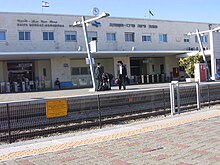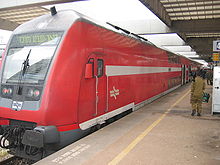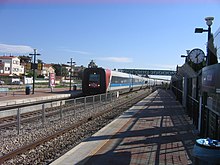Nahariya – Be'er Sheva railway line
| Main line Nahariya – Beer Sheva | |||||||||||||||||||||||||||||||||||||||||||||||||||||||||||||||||||||||||||||||||||||||||||||||||||||||||||||||||||||||||||||||||||||||||||||||||||||||||||||||||||||||||||||||||||||||||||||||||||||||||||||||||||||||||||||||||||||||||||||||||||||||||||||||||||||||||||||||||||||||||||||||||||||||||||||||||||||||||||||||||||||||||||||||||||||||||||||||||||||||||||||||||||||||||||||||||||||||||||||||||||||||||||||||||||||||||||||||||||||||||||||||||||||||||||||||||||||||||||||||||||||||||||||||||||||||||||||||||||||||||||||||||||||||||||||||||||||
|---|---|---|---|---|---|---|---|---|---|---|---|---|---|---|---|---|---|---|---|---|---|---|---|---|---|---|---|---|---|---|---|---|---|---|---|---|---|---|---|---|---|---|---|---|---|---|---|---|---|---|---|---|---|---|---|---|---|---|---|---|---|---|---|---|---|---|---|---|---|---|---|---|---|---|---|---|---|---|---|---|---|---|---|---|---|---|---|---|---|---|---|---|---|---|---|---|---|---|---|---|---|---|---|---|---|---|---|---|---|---|---|---|---|---|---|---|---|---|---|---|---|---|---|---|---|---|---|---|---|---|---|---|---|---|---|---|---|---|---|---|---|---|---|---|---|---|---|---|---|---|---|---|---|---|---|---|---|---|---|---|---|---|---|---|---|---|---|---|---|---|---|---|---|---|---|---|---|---|---|---|---|---|---|---|---|---|---|---|---|---|---|---|---|---|---|---|---|---|---|---|---|---|---|---|---|---|---|---|---|---|---|---|---|---|---|---|---|---|---|---|---|---|---|---|---|---|---|---|---|---|---|---|---|---|---|---|---|---|---|---|---|---|---|---|---|---|---|---|---|---|---|---|---|---|---|---|---|---|---|---|---|---|---|---|---|---|---|---|---|---|---|---|---|---|---|---|---|---|---|---|---|---|---|---|---|---|---|---|---|---|---|---|---|---|---|---|---|---|---|---|---|---|---|---|---|---|---|---|---|---|---|---|---|---|---|---|---|---|---|---|---|---|---|---|---|---|---|---|---|---|---|---|---|---|---|---|---|---|---|---|---|---|---|---|---|---|---|---|---|---|---|---|---|---|---|---|---|---|---|---|---|---|---|---|---|---|---|---|---|---|---|---|---|---|---|---|---|---|---|---|---|---|---|---|---|---|---|---|---|---|---|---|---|---|---|---|---|---|---|---|---|---|---|---|---|---|---|---|---|---|---|---|---|---|---|---|---|---|---|---|---|---|---|---|---|---|---|---|---|---|---|---|---|---|---|---|---|---|---|---|---|---|---|---|---|---|---|---|---|---|---|---|---|---|---|---|---|---|---|---|---|---|---|---|---|---|---|---|---|---|---|---|---|---|---|---|---|---|---|---|---|---|---|---|---|---|---|---|---|---|---|---|---|---|---|---|---|---|---|---|---|---|---|---|---|---|---|---|---|---|---|---|---|---|---|---|---|---|---|---|---|---|---|---|---|---|---|---|---|---|---|---|---|---|---|---|---|---|---|---|---|---|---|---|---|---|---|---|---|
|
Double-decker train near Haifa
| |||||||||||||||||||||||||||||||||||||||||||||||||||||||||||||||||||||||||||||||||||||||||||||||||||||||||||||||||||||||||||||||||||||||||||||||||||||||||||||||||||||||||||||||||||||||||||||||||||||||||||||||||||||||||||||||||||||||||||||||||||||||||||||||||||||||||||||||||||||||||||||||||||||||||||||||||||||||||||||||||||||||||||||||||||||||||||||||||||||||||||||||||||||||||||||||||||||||||||||||||||||||||||||||||||||||||||||||||||||||||||||||||||||||||||||||||||||||||||||||||||||||||||||||||||||||||||||||||||||||||||||||||||||||||||||||||||||
| Gauge : | 1435 mm ( standard gauge ) | ||||||||||||||||||||||||||||||||||||||||||||||||||||||||||||||||||||||||||||||||||||||||||||||||||||||||||||||||||||||||||||||||||||||||||||||||||||||||||||||||||||||||||||||||||||||||||||||||||||||||||||||||||||||||||||||||||||||||||||||||||||||||||||||||||||||||||||||||||||||||||||||||||||||||||||||||||||||||||||||||||||||||||||||||||||||||||||||||||||||||||||||||||||||||||||||||||||||||||||||||||||||||||||||||||||||||||||||||||||||||||||||||||||||||||||||||||||||||||||||||||||||||||||||||||||||||||||||||||||||||||||||||||||||||||||||||||||
|
|||||||||||||||||||||||||||||||||||||||||||||||||||||||||||||||||||||||||||||||||||||||||||||||||||||||||||||||||||||||||||||||||||||||||||||||||||||||||||||||||||||||||||||||||||||||||||||||||||||||||||||||||||||||||||||||||||||||||||||||||||||||||||||||||||||||||||||||||||||||||||||||||||||||||||||||||||||||||||||||||||||||||||||||||||||||||||||||||||||||||||||||||||||||||||||||||||||||||||||||||||||||||||||||||||||||||||||||||||||||||||||||||||||||||||||||||||||||||||||||||||||||||||||||||||||||||||||||||||||||||||||||||||||||||||||||||||||
The Nahariya – Beer Sheva railway line ( Hebrew הַקַּו הָרָאשִׁי ha-Qaw ha-Raschi , German for 'the main line' ) is the central thoroughfare for passenger traffic on the Israeli railway Rakkevet Israel (RI) . It's not electrified . All trains are pulled by diesel locomotives or diesel multiple units are used. There are single and double track sections.
history
Historical basis
Historically, this route was created from sections of a number of railway lines, today in some cases still legible from the multiple broken kilometers . This is based on the particularly changeful history of the railroad in Israel and its predecessor territories, because with every upheaval in the political system since the Ottoman Empire , the railroad system was largely destroyed and rebuilt in a modified form, but also with remnants of the previous system.
Sections
When Israel, when it was founded in 1948, took over the parts of the railroad systems of the Mandate Territory of Palestine located on its territory, this also included parts of what is now the Nahariya - Beersheba line . The components of the Naharija – Be'er Scheva route were created as follows (from north to south):
Nahariya-Haifa-Mizrach

The southern section of the standard-gauge Haifa – Beirut – Tripoli (HBT) railway line built by the British military with US help during World War II , which was now cut off at the Lebanese border, formed the northernmost section of the Mizrach network between Naharija and Haifa Mizrach Rakkevet Israel (RI) . With the extension along the coast from the connection from Remez to Tel Aviv in 1954, it is used as a coastal railway ( Hebrew מְסִלַּת הָחוֹף Məsillat ha-Chof , German for 'Railway of the Coast' ). Haifa Mizrach (Ostbahnhof) was the main train station of Haifa at that time and is still the beginning of the kilometering for the former HTB, that was for the narrow-gauge Jezreel Valley Railway Haifa – Dar'a in the direction of Damascus and it is also for the standard-gauge coastal railway following the HTB to the south.
Haifa-Mizrach-Remez Junction
The subsequent section, the standard-gauge line from Haifa to Remez Junction at km 48.5, built by the British military during the First World War , is the northern part of the former connection between Haifa and al-Qantara on the Suez Canal in Egypt . It was part of the Palestine Railways after the First World War.
After the establishment of the State of Israel in 1948, the main line of the Palestine Railways in the area of the Eastern Railway near Tulkarm was cut up and interrupted by the Green Line to Jordan , so that initially an island operation was created. This was reconnected to the rest of the Israeli network in 1949 by a bypass route. For the Haifa - Tel Aviv connection , however, this still meant extensive bypassing of the Tel Aviv agglomeration from the north along its eastern edge by east rail south to the old Tel Aviv Darom station, which was located there between 1920 and 1970 . In addition, the train had to be turned around en route in Lod , at the change from the Eastern Railway to the J&J line .
Remez Junction – Tel Aviv Savidor Merkaz
In contrast to the mandate period in Palestine, in which the port city of Haifa was the central settlement focus until the second half of the 1930s, Tel Aviv as a city and metropolitan area overtook Haifa in both characteristics, which has continued since the existence of Israel from 1948. The cumbersome traffic routing from Haifa to Tel Aviv, which once led around the city, was far too slow from the start.
A new, direct route between Tel Aviv and Haifa along the coast was planned since 1949. It branched off at Remez Junction at km 48.5 from the old main line to the south, aimed directly at the northern outskirts of Tel Aviv and is now the southern strand of the coastal railway and part of the main Nahariya – Beersheba line . On November 4, 1954, the line was introduced to the new Tel Aviv Merkaz (Tel Aviv Center) station on the northern outskirts of Tel Aviv. The station was later named Arlosoroff after the nearby Rechov Chaim Arlosoroff street . Since 1988 the official name is Tel Aviv Savidor Merkaz (about Tel Aviv Savidor Central Station). The station was built on what was then an open field.
The distance to the city center to the south was so great that it could usually not be reached on foot. In the early 1980s, the shortest travel time between Haifa and Tel Aviv was just over an hour. At that time, the seamlessly welded track and safety by means of light signals were introduced on the still single-track stretch of the coastal railway between Tel Aviv and Haifa. From around 1990 the coast line of the main Tel Aviv – Haifa line was expanded and approved for 105 km / h, and a second track was laid on some sections. The aim was to increase the top speed. During test drives, 125 km / h were achieved. The double-track sections are designed for track-changing traffic, but left-hand traffic is generally intended. Since July 19, 1997, the shortest travel time has only been 49 minutes. Today, the timetable usually provides one hour of travel time.
Tel Aviv Savidor Merkaz – Tel Aviv Darom
The stations in the north of Tel Aviv, Tel Aviv Merkaz at the end of the coastal tram, and in the south, which opened in 1970, two and a half kilometers from the old Tel Aviv new south station at the shortened beginning of the J&J line , remained without a direct connection for a long time. Traffic between them was theoretically possible with an approx. 45 km long bypass of Tel Aviv using the Jarqon Railway, Eastern Railway and J&J Line, but was never offered.
The direct connection, which is just over four kilometers long, was not established until 1993. Space for the new route was created by channeling the river Ajjalon, which runs between the directional lanes of the north-south urban motorway . However, when it was raining heavily, the tracks were occasionally flooded. On the occasion of this expansion was the railhead Tel Aviv Merkaz by a slightly shifted eastward through station replaced the original station building of Ossip clear wine was preserved and connected to the new platforms by Passarelle.
Tel Aviv Darom-Na'an
The subsequent line from the new South Station (Tel Aviv Darom) opened in 1970 via Lod to Na'an is part of the country's first railway line, the Jaffa – Jerusalem line (J&J line) .
Na'an – Be'er Scheva Zafon / Universita
The line between Na'an and Beer Sheva was opened on March 29, 1956. With a length of 73 kilometers it was the longest new line of the Rakkevet Israel (IR) to date . The line partly uses the routes of the military line Maṣʿūdiyya – Sinai, which was built in 1915 and closed in this section in 1927, and partly newly constructed or straightened sections. Passenger traffic to Beersheba ceased between 1979 and early 1997.
Be'er Scheva Zafon / Universita – Be'er Scheva Merkaz
The section from Be'er Scheva station, which was renamed Be'er Scheva Zafon / Universita (north / university) station on this occasion , to the Be'er Scheva Merkaz head station is the youngest section of the connection and was put into operation in 1999 . The Zafon / Universita train station was relocated 250 m to the north-west and inaugurated there in 2005 as a new building.
Present and Future
The line is to be electrified in the coming years .
It is to be laid in a tunnel in the downtown area of Haifa . The current central station of Haifa, Haifa Merkaz haSchmonah from 1937, is to be relocated about 800 meters to the north in a tunnel station and closer to the city center. The main purpose of the project is to reopen the western part of the port, cut off from the city by the railway line, to build 7,700 new apartments and hotels and to create recreational opportunities in this area. The relocation of the railway infrastructure in the tunnel is expected to cost € 310 million.
traffic
description
The Naharija – Be'er Scheva railroad is the result of the topography of the main settlements in Israel, which are lined up along the coast in a north-south axis and whose center is Tel Aviv. Only with the upswing of rail traffic in Israel in the 1990s did it develop in terms of transport. In its central section in Tel Aviv, it bundles six of eight connections that the RI offers in passenger transport.
In addition, another line runs between Haifa Hof haKarmel and Qirjat Motzkin on this route. Only the branch connection Be'er Scheva Zafon / Universita - Dimona does not use it as the only offer of the RI in the passenger traffic. In terms of timetable, this means that rail traffic for the entire country can be clearly displayed in two timetable tables: one for north-south traffic and one for the opposite direction.
The structure of rail passenger transport in Israel is similar to that of a S-Bahn system. On the one hand, this is expressed in the almost complete, nationwide timing of rail traffic. There is also a bundling of the majority of the train traffic in the Ajalon corridor in Tel Aviv. Its central part is the section between the Tel Aviv Savidor Merkaz and Tel Aviv haHagana stations. Ten trains per hour run here on weekdays (Sunday - Thursday) in each direction.
Overview
| offer | runs on the Nahariya – Beer Sheva main line between the stations |
|---|---|
| Nahariya - Beer Sheva | all in all |
| Nahariya - Ben Gurion Airport - Modi'in Merkaz | Nahariya – Tel Aviv ha-Hagana |
| Binjamina - Ashkelon | Binyamina - Lod |
| Kfar Saba - Rishon LeZion -ha-Rishonim | Tel Aviv Universita-Lod |
| Tel Aviv Savidor Merkaz – Be'er Scheva | all in all |
| Tel Aviv Savidor Merkaz - Jerusalem-Malcha | Tel Aviv Savidor Merkaz– Na'an |
| Haifa Chof ha-Karmel - Qirjat Motzkin | all in all |
literature
- Paul Cotterell: The Railways of Palestine and Israel . Tourret Books, Abington 1986, ISBN 0-905878-04-3 .
- Georg Fladt-Stähle: The Railway in Israel . In: Eisenbahn-Revue International 12/2009, pp. 652–655.
- Israel Railways / Rakkevet Israel: Train Schedule. Effective March 15, 2008. Update February 7, 2009 until further notice. Summer 2008 . o. O.
- Neil Robinson: World Rail Atlas and historical summary . Volume 8: The Middle East and Caucasus. 2006.
- Walter Rothschild : Arthur Kirby and the last years of Palestine Railways: 1945–1948 , Berlin: Selbstverlag, 2009, plus London King's College Diss., 2009.
Individual evidence
-
↑ See also:
- Ottoman Empire: Jaffa – Jerusalem Railway (J&J) , Hejaz Railway
- First World War: Ottoman Military Railroad in Palestine
- League of Nations mandate Palestine: Palestine Railways , Haifa – Beirut – Tripoli military railway
- Israel: Rakkevet Israel (RI)
- ^ City of Haifa: Press release of November 3, 2015. In: Ha Rakevet 111 (December 2015), xxii. The Line Trough Haifa to Go Underground , p. 7.





